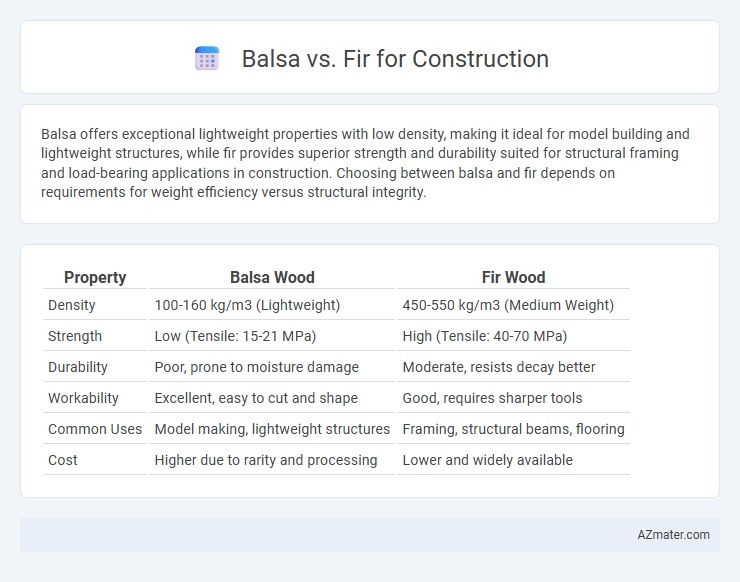Balsa offers exceptional lightweight properties with low density, making it ideal for model building and lightweight structures, while fir provides superior strength and durability suited for structural framing and load-bearing applications in construction. Choosing between balsa and fir depends on requirements for weight efficiency versus structural integrity.
Table of Comparison
| Property | Balsa Wood | Fir Wood |
|---|---|---|
| Density | 100-160 kg/m3 (Lightweight) | 450-550 kg/m3 (Medium Weight) |
| Strength | Low (Tensile: 15-21 MPa) | High (Tensile: 40-70 MPa) |
| Durability | Poor, prone to moisture damage | Moderate, resists decay better |
| Workability | Excellent, easy to cut and shape | Good, requires sharper tools |
| Common Uses | Model making, lightweight structures | Framing, structural beams, flooring |
| Cost | Higher due to rarity and processing | Lower and widely available |
Introduction to Balsa and Fir Woods
Balsa wood, known for its lightweight and low-density properties, is often used in model building and insulation due to its excellent strength-to-weight ratio. Fir wood, particularly Douglas Fir, is renowned for its durability, strength, and resistance to decay, making it a popular choice in structural applications and heavy construction. While balsa offers exceptional ease of handling and flexibility, fir provides robust support and long-term stability in building projects.
Physical Properties Comparison
Balsa wood boasts an exceptionally low density of around 160 kg/m3, making it one of the lightest woods used in construction, while fir has a higher density near 450 kg/m3, providing greater structural strength and durability. Fir exhibits superior compressive strength and stiffness, with a modulus of elasticity averaging 12 GPa, compared to balsa's approximately 3 GPa, making fir more suitable for load-bearing applications. Moisture resistance and dimensional stability in fir surpass those of balsa, which tends to absorb water and lose mechanical properties under humid conditions.
Strength and Durability Analysis
Balsa wood exhibits low density and moderate tensile strength, making it lightweight but less durable for heavy structural applications compared to fir. Fir wood offers higher compressive strength and superior resistance to wear and environmental factors, making it more suitable for construction requiring long-term durability. Strength-to-weight ratio favors fir in framing, while balsa is often reserved for non-load-bearing or prototype uses due to its fragility.
Weight and Density Differences
Balsa wood is significantly lighter than fir, with a density typically around 160 kg/m3 compared to fir's density of approximately 530 kg/m3, making balsa ideal for applications requiring minimal weight. The low density of balsa provides excellent strength-to-weight ratio, often used in lightweight structural components and model construction. Fir's higher density offers greater sturdiness and durability, suitable for load-bearing frameworks and exterior construction where strength is prioritized over weight reduction.
Workability and Ease of Use
Balsa wood offers superior workability due to its lightweight and soft texture, allowing easy cutting, shaping, and sanding even with basic tools. Fir, while denser and harder, provides more strength but requires sharper tools and greater effort to manipulate, impacting ease of use for intricate designs. For construction projects that prioritize quick handling and minimal tool wear, balsa is preferable, whereas fir suits applications demanding structural robustness despite increased labor.
Cost and Availability Factors
Balsa wood tends to be more expensive than fir due to its lightweight properties and limited availability, primarily sourced from South America. Fir is widely available in North America and Europe, making it a cost-effective option for large-scale construction projects. The abundant supply and lower price of fir contribute to its popularity in structural applications, whereas balsa's price and rarity often limit its use to specialized, lightweight designs.
Suitability for Various Construction Projects
Balsa wood offers exceptional lightweight properties and buoyancy, making it ideal for model building, prototypes, and lightweight structures where strength-to-weight ratio is crucial. Fir provides greater density and strength, suitable for structural framing, beams, and load-bearing applications in residential and commercial construction. The suitability of balsa versus fir depends on project requirements: balsa excels in low-stress, lightweight projects, while fir is preferred for durability and structural integrity.
Environmental Impact and Sustainability
Balsa wood, known for its rapid growth and high carbon sequestration rate, offers a more sustainable option compared to fir due to its renewable nature and lower environmental footprint. Fir, while strong and durable, typically requires longer growth periods, resulting in higher resource consumption and greater ecological impact. Utilizing balsa in construction reduces deforestation pressure and promotes faster regeneration of forest ecosystems, aligning with sustainable building goals.
Maintenance and Longevity
Balsa wood offers low maintenance due to its natural resistance to rot and lightweight properties, but it is generally less durable and prone to denting compared to fir. Fir wood exhibits higher longevity with excellent structural strength and better resistance to wear, making it a preferred choice for long-term construction projects. Maintenance requirements for fir include periodic sealing and treatment to prevent decay, while balsa's softer texture demands careful handling to avoid damage over time.
Choosing the Right Wood for Your Project
Balsa wood, known for its exceptional lightness and softness, is ideal for models and prototypes where weight reduction is crucial, while fir is favored for structural construction due to its strength, durability, and resistance to warping. Fir's higher density and dimensional stability make it suitable for framing, flooring, and outdoor applications, providing reliable support and longevity. Selecting the right wood depends on the project's load-bearing requirements, environmental exposure, and desired finish, prioritizing fir for strength and balsa for lightweight needs.

Infographic: Balsa vs Fir for Construction
 azmater.com
azmater.com